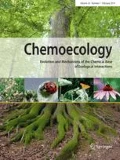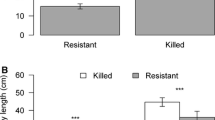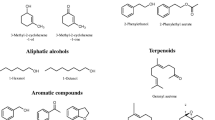Summary.
This review summarizes the literature related to the chemical ecology of the Cerambycidae and provides a brief overview of cerambycid biology, ecology, economic significance, and management. Beetles in the family Cerambycidae have assumed increasing prominence as pests of forest and shade trees, shrubs, and raw wood products, and as vectors of tree diseases. Exotic species associated with solid wood packing materials have been notable tree killers in North American urban and peri-urban forests. In forested ecosystems native species respond to disturbances such as fires and windstorms, and initiate the biodeterioration of woody tissue. Eggs are laid by females, on or through the bark surface of stem and branch tissue of moribund, recently killed or decomposing woody plants; larval cerambycids (roundheaded woodborers) typically feed in the phloem and later in the xylem. Females will also, in some cases, select living hosts, e.g. adult conifer and angiosperm trees, for oviposition. Research on the chemical ecology of over 70 species has revealed many examples of attractive kairomones (such as floral volatiles, smoke volatiles, trunk and leaf volatiles, and bark beetle pheromones), repellents and deterrents, oviposition stimulants, short- and long-range sex pheromones, and defensive substances. Emerging generalities are that attractants tend to be monoterpenoids and phenolic esters; oviposition stimulants are monoterpenoids and flavanoids; short-range sex pheromones are female-produced, methyl-branched cuticular hydrocarbons; and long-range sex pheromones are male-produced α-hydroxy ketones and (α,β)-diols ranging in length from 6 to 10 carbons. The latter compounds appear to originate from glands in the male thorax; putative defensive substances originate from metasternal secretory pores or mandibular glands. In one unusual case, a flightless, subterranean female that attacks sugar cane produces a sex pheromone that is derived from the amino acid isoleucine. With significantly more than 35,000 species of Cerambycidae worldwide, these generalities will be subject to change as more species are examined.
Similar content being viewed by others
Author information
Authors and Affiliations
Corresponding author
Additional information
Addendum
The authors would like to point out that the electronic version is more accurate than the printed version.
Rights and permissions
About this article
Cite this article
Allison, J., Borden, J. & Seybold, S. A review of the chemical ecology of the Cerambycidae (Coleoptera). Evolutionary, Mechanistic and Environmental Approaches to Chemically-Mediated Interactions 14, 123–150 (2004). https://doi.org/10.1007/s00049-004-0277-1
Received:
Accepted:
Issue Date:
DOI: https://doi.org/10.1007/s00049-004-0277-1




